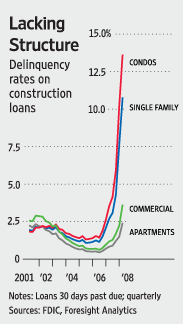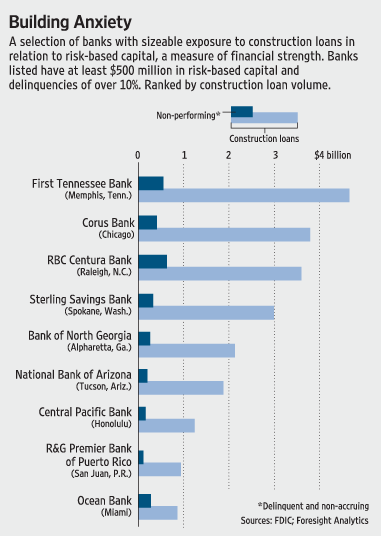Wall Street is bracing for regional and small banks to fess up to large losses from their mounting volume of soured construction loans made primarily to home builders.
According to the Federal Deposit Insurance Corp., $45.4 billion of the $631.8 billion in construction loans outstanding at the end of the first quarter were delinquent. When banks announce second-quarter results in coming weeks, they are expected to report sharp increases in loans that builders can’t repay. Banks are also facing intensifying pressure from federal and state regulators to deal with the problem loans on their books.

WHICH BANKS WILL FEEL THE PAIN?
See a sortable list of small and regional banks with sizable exposure to construction and land loans and with notable delinquency rates.

That will put additional pressure on an already stressed financial system. Banks have begun to dump bad construction and land loans at discounts, curtail new lending and halt construction projects that are under way to preserve capital. Some analysts even see a wave of bank failures as a possibility.
“Across the industry, the second quarter is going to be a tough quarter,” says Keith Maio, chief executive of the National Bank of Arizona, a unit of Zions Bancorp, which lent heavily to home builders and developers. “It’s going to continue to be tough until the real-estate market hits a bottom.”
Scores of banks were already suffering headaches by the end of the first quarter, according to a review by The Wall Street Journal of FDIC-filed reports by 6,919 banks that make construction loans. The smallest banks, those with total assets of less than $5 billion, faced the biggest problems. The WSJ analysis didn’t include savings-and-loan institutions, or so-called thrift banks.
Nearly one in three of the banks analyzed — or 2,182 — had construction-loan portfolios that exceeded 100% of their total risk-based capital, a red flag to regulators, although it doesn’t mean the bank is in danger of failing. Risk-based capital is a cushion that banks can dig into to cover losses.
Even more alarming, 73 of those banks had construction-loan delinquency rates of more than 25%. Executives at all of the banks that responded to questions acknowledged the problems but expressed confidence they had the capital to weather the storm.
At Bremerton, Wash.-based Westsound Bank, new Chief Executive Terry Peterson agreed that his bank became “much, much too concentrated” in construction loans. About 43% of Westsound Bank’s construction and land loans in the first quarter were delinquent.
Mr. Peterson was appointed CEO recently to clean up the troubled bank, after regulators issued a “cease and desist” order in March requiring the bank to change lending practices. “We are pretty much using all of our human capital to address our loan problems,” he says.
Larger regional banks also face mounting construction-loan problems, but are in decent shape. Thirty-eight of them had more than 100% of their total risk-based capital in construction loans at the end of the first quarter, but only nine of those faced delinquency rates of more than 10%.
Over the next few quarters, banks are expected to begin recording much larger losses. In 2007 and the first quarter of this year, U.S. banks wrote down just 0.7% of their residential construction and land assets as bad debt, according to Zelman & Associates, a research firm. Over the next five years that figure could rise to 10% and 26%, which would amount to about $65 billion to $165 billion, Zelman projects.
During the housing boom, many small and regional banks doubled down on construction loans because they were largely shut out of the home mortgage market dominated by large originators. But now the banks’ difficulties are threatening to sharply shrink the home-building industry. Credit Suisse analyst Dan Oppenheim estimates that as many as 50% of the closely held builders won’t survive because of the tightening lending environment and housing downturn.
Strategies for coping with the problem loans vary widely. Large banks, such as IndyMac Bancorp Inc. and KeyBank, have been trying to sell billions of dollars of construction and land loans. IndyMac said in a filing Monday that it is working with regulators to shore up its capital. (See related article.)
“The banks are running as fast as they can to get out of housing,” says Tom McCormick, president of Astoria Homes, a large, closely held builder in Las Vegas.
Mr. McCormick is involved in a fight with KeyBank, which recently initiated foreclosure proceedings on a $24 million construction loan financing a Las Vegas housing project. Mr. McCormick says the bank took that action even though his company was current on debt payments. In court documents, KeyBank says the builder fell behind.
Mr. McCormick says he found investors to buy out his loans at 70 cents on the dollar, but the bank refused. He also says that KeyBank has prevented him from closing home sales. “I personally think the fact that you would punish any innocent home buyer…is shameful,” Mr. McCormick wrote in an email to KeyBank executives. A spokeswoman for KeyCorp, KeyBank’s parent, declined to comment.
Many smaller banks have been more willing to work with struggling builders rather than foreclose on their projects. But these banks are coming under pressure from regulators to more aggressively write down their loans, amid declining real-estate values. This process could force many more loans into default.
Some community banks are bristling under the regulatory pressure. “The federal government is being too reactionary,” says Damian Kassab, chief executive of Michigan-based Warren Bank, which reported that 47% of its construction loans are delinquent. “They want to see it done as quickly as possible. I say ‘can’t we just relax, take a deep breath and work with the borrowers.'”
Analysts question whether some small banks are putting off foreclosures because they lack adequate capital to absorb the large losses.
Banks seeking a quick fix by selling off their troubled loans may find fewer buyers. Laurence Pelosi, an executive director of Morgan Stanley Real Estate, a major land investor, told the Pacific Coast Builders Conference last week that the appetite for distressed residential real estate may be waning among some investors. “The complexity of the business and the increasing opportunities in the commercial sector may lead to a shift away from residential,” Mr. Pelosi says. “That will have a further impact on values.”
–Tom McGinty contributed to this article.
Write to Michael Corkery at [email protected], Jennifer S. Forsyth at [email protected] and Lingling Wei at [email protected]
By MICHAEL CORKERY, JENNIFER S. FORSYTH and LINGLING WEI
July 2, 2008
Source: The Wall Street Journal